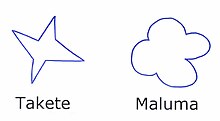Appearance
The impression (also impression quality ) of an object or a situation is the difficult to determine, rather vague effect of this appearance on a viewer via one or more perception channels ( visual , auditory , haptic , olfactory ). It depends on the properties of the object being viewed or the features of an experienced situation, as well as the socialization of the viewer and the environment in which the object is represented or the situation occurs.
Originally the word meant something completely different, namely an imposition .
Design and art
When it comes to graphical user interfaces ( GUI ) of computers, one usually speaks of look and feel .
Designers and artists use creative means to convey values and qualities and, in doing so, also focus on subliminal impressions. They are specially trained for the anticipation of objects by different viewers and target groups.
In design practice, appearance is used to describe the often unconscious expectations aroused by a design. The spontaneous impression is an important indicator for the consistency of intention and form of a design. In graphic design , for example, a convincing pack of cigarettes should not look like a cosmetic product, a signet design for a bank should not be mistaken for that of a fast food chain, etc.
Vowel quality and vowel quantity
As early as the 1920s it was shown that high, front vowels such as / i / are more likely to be associated with small objects and low, rear vowels such as / u / with large objects. Not only the vowel quality (e.g. / i / versus / u /) seems to play a role in this effect, but also the vowel quantity (long versus short vowels). Test subjects tend to associate words with short vowels (e.g. "mutto") with short objects and words with long vowels (e.g. "muhto") with elongated objects - although the vowel quality is temporal Property and the extent of an object is visual.
Maluma and Takete
The psychologist Wolfgang Köhler , one of the founders of Gestalt psychology , carried out fundamental research to prove the quality of appearance in 1929. Köhler presented test subjects with a round and an angular figure and asked them to assign the word Maluma or the word Takete to the shapes . In 90% of the cases, the subjects assigned the round shape to Maluma and the pointed shape to Takete .
From this, Köhler derived the proof that there is an intuitive, emotional connection between language and optical representations, i.e. sounds correspond to the perception of shapes.
Bouba and Kiki
In 2001, VS Ramachandran and Edward Hubbard replicated Koehler 's experiment with the non- words kiki and bouba and asked American and Indian Tamil speakers to match them with the outlines opposite. In both groups, 95% to 98% assigned the curvy shape to bouba and the jagged shape to kiki . The human brain should therefore combine abstract forms and sounds in a consistent way.
Web links
- Maluma and Takete
- Appearance quality. In: Lexicon of Psychology. Wissenschaft-online.de
- Appearance. In: Gabler Wirtschaftslexikon.
Individual evidence
- ↑ G. Truig: German dictionary. Gütersloh 1974, ISBN 3-570-06588-X .
- ^ Edward Sapir: A study in phonetic symbolism. In: Journal of Experimental Psychology. 12, 1929, pp. 2251-1239.
- ↑ Fabian Bross: Cognitive associations between vowel length and object size: A new feature contributing to a bouba / kiki effect. In: M. Belz, C. Mooshammer, S. Fuchs, S. Jannedy, O. Rasskazova, M. Zygis (Eds.): Proceedings of the Conference on Phonetics & Phonology in German-Speaking Countries. Humboldt University, Berlin 2018, pp. 17–20.
- ↑ Article in oktopus

